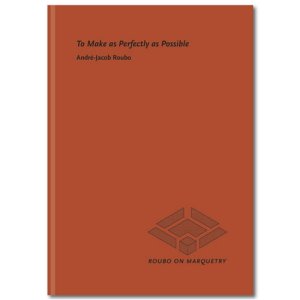
BOOK REVIEW:
Roubo, To Make as Perfectly as Possible, by Andre Jacob Roubo
by J. Norman Reid
Delaplane, VA
In the 1760s, André-Jacob Roubo was commissioned by the French Royal Academy to write a treatise on furniture-making practice. In 1768, he delivered his work to the Academy. The result was a massive masterwork that described in great detail the methods of French woodworking artisans in pursuit of their highest art and craft. To Make as Perfectly as Possible, the first English translation of a portion of Roubo's treatise, addresses the practice of marquetry in all its forms.
The product of several years' labor, the translation project was a collaborative effort spearheaded by Don Williams, himself a furniture restoration specialist and a practitioner of marquetry with several decades' experience. A companion volume on furniture-making is currently being translated by the same team. Though Williams did not make the translations himself, his contribution to the project was major. Not only did he edit the raw translation of 18th century French into fresh, highly readable and comprehensible English, but at critical points in the text he inserted helpful sidebars that further explained Roubo's messages and translated them into contemporary practice, additions that go a long way in helping readers apply Roubo's advice to their own work.
Though Roubo wrote two and a half centuries ago, his advice is timeless. The volume opens with a review of the variety of woods–foreign and French–appropriate for cabinetry and assesses their color and working characteristics. Roubo next discusses dyes and how to use them. Following that is a treatment of sawing wood for cabinetry and veneering, including the methods for holding it. Cabinetmakers' tools are discussed as well, including workbenches, vises, grindstones and planes. This opening section concludes with a survey of the forms of cabinetry appropriate for veneering.
Like Caesar's Gaul, the bulk of the volume is divided into three parts, here according to styles of marquetry. The first is what he terms "simple marquetry," which he distinguishes from pictorial marquetry. Roubo discusses and illustrates a variety of compositions employing both color and grain patterns in designs of increasing complexity. In addition, he considers the tools and methods for cutting both straight and curved pieces, gluing and veneering, and finishing and polishing.
The second type of marquetry, which he terms "ornate cabinetry," refers to mosaic or painting-like effects. This section opens with a review of principles of perspective, which Roubo regards as essential knowledge for this type of work. Cutting, gluing and inlaying are considered next, then engraving and finishing. Also discussed are the methods for representing flowers, figures, fruits and pastoral scenes in highly ornate forms of marquetry.
The final type of marquetry he calls "veneered cabinetry." This type involves the application of non-wooden materials, including tortoiseshell, ivory, horn, mother-of-pearl, whale, brass, pewter, silver and gold. Roubo assesses different means of attaching these materials and how to prepare them for inlaying. Major attention is given to preparing and applying tortoiseshell, which was regarded as the most highly desirable and workable of the materials. The section is finished with a description of the types of works to which these materials are typically applied–noteably clocks–and methods for finishing inlay that uses these types of materials.
The book is well-illustrated throughout by Roubo's detailed drawings and in the sections written by Williams is supplemented with photos that help explain the methods and processes he presents.
This work is destined to be a classic in the literature on woodworking. As an encyclopedic compendium of marquetry techniques, it will certainly be of major importance for anyone pursuing that craft. But its appeal for woodworkers goes far deeper. Roubo's work illuminates historic practices in woodworking and will also interest any reader who is fascinated with the history of our craft. Yet, possibly Roubo's greatest gift to us is his continual emphasis on the importance of skilled and careful technique in his quest "to make as perfectly as possible," and this book ought to serve as an inspiration to each of us to strive to do our best work at all times. This rediscovered classic is highly recommended.
CLICK HERE to purchase your own copy
of
To Make as Perfectly as Possible
The author is a woodworker, writer, and woodworking instructor living with his wife in the foothills of the Blue Ridge Mountains with a woodshop full of power and hand tools and four cats who believe they are cabinetmaker's assistants.
He can be reached by email at
nreid@fcc.net
.
Return to
Wood News
front page


